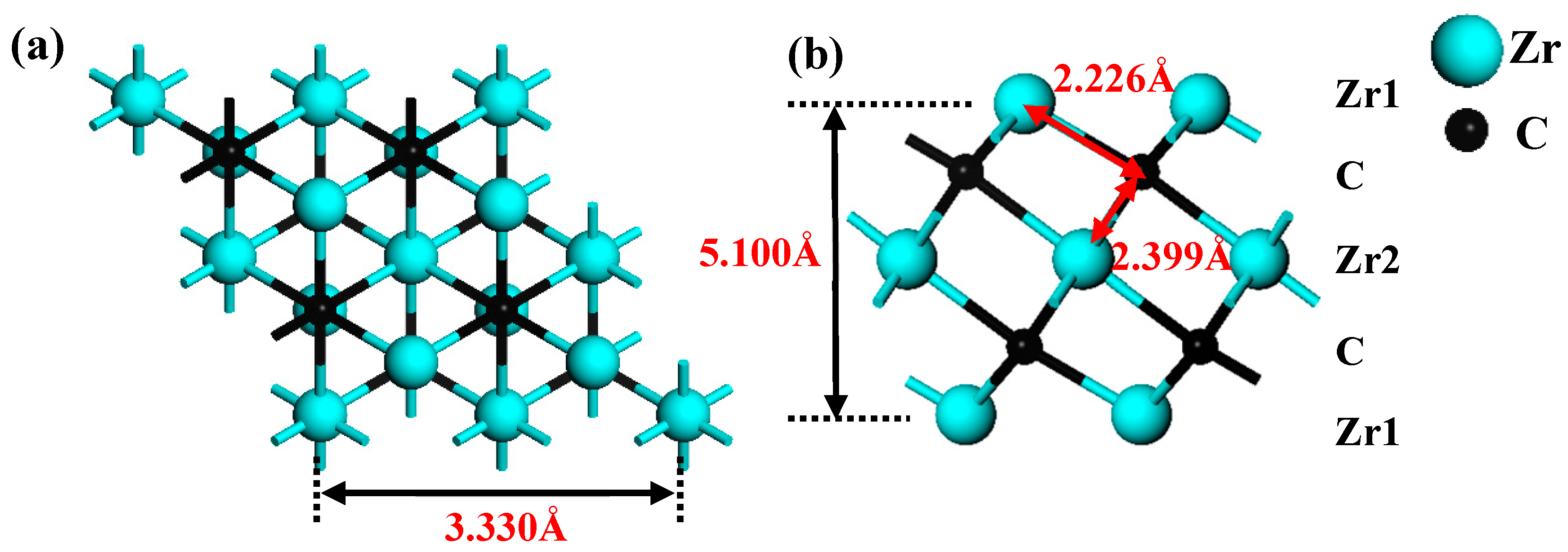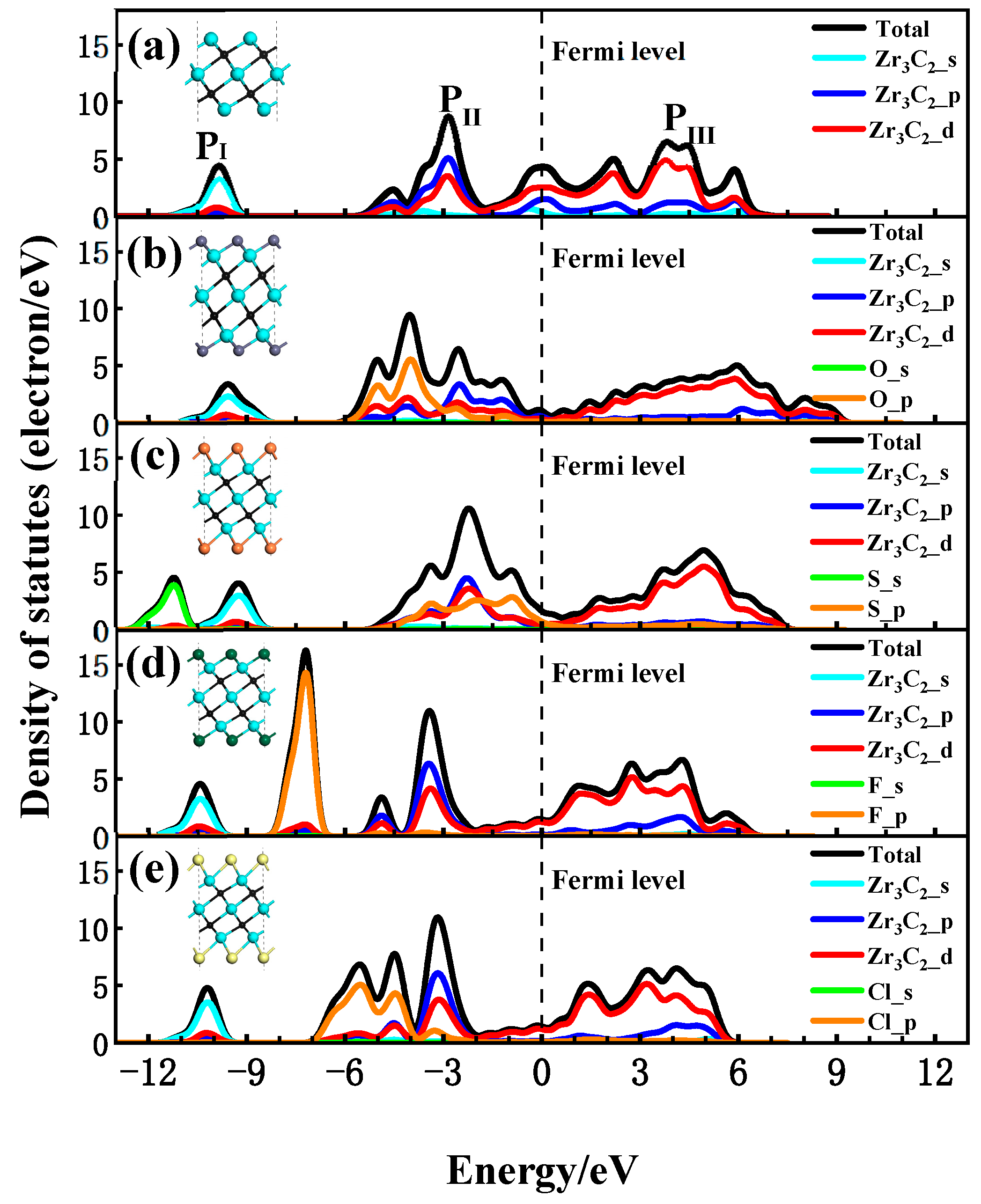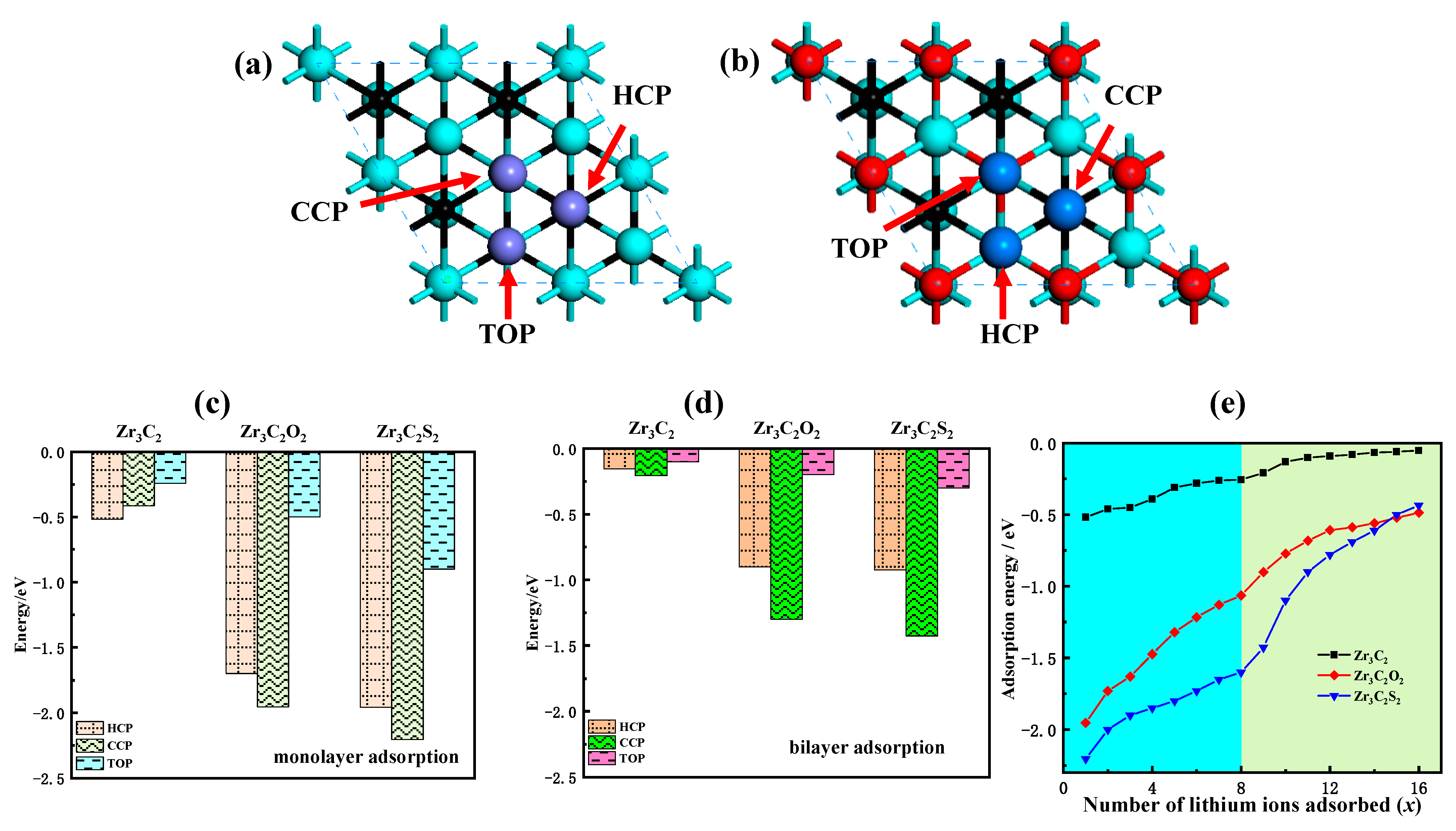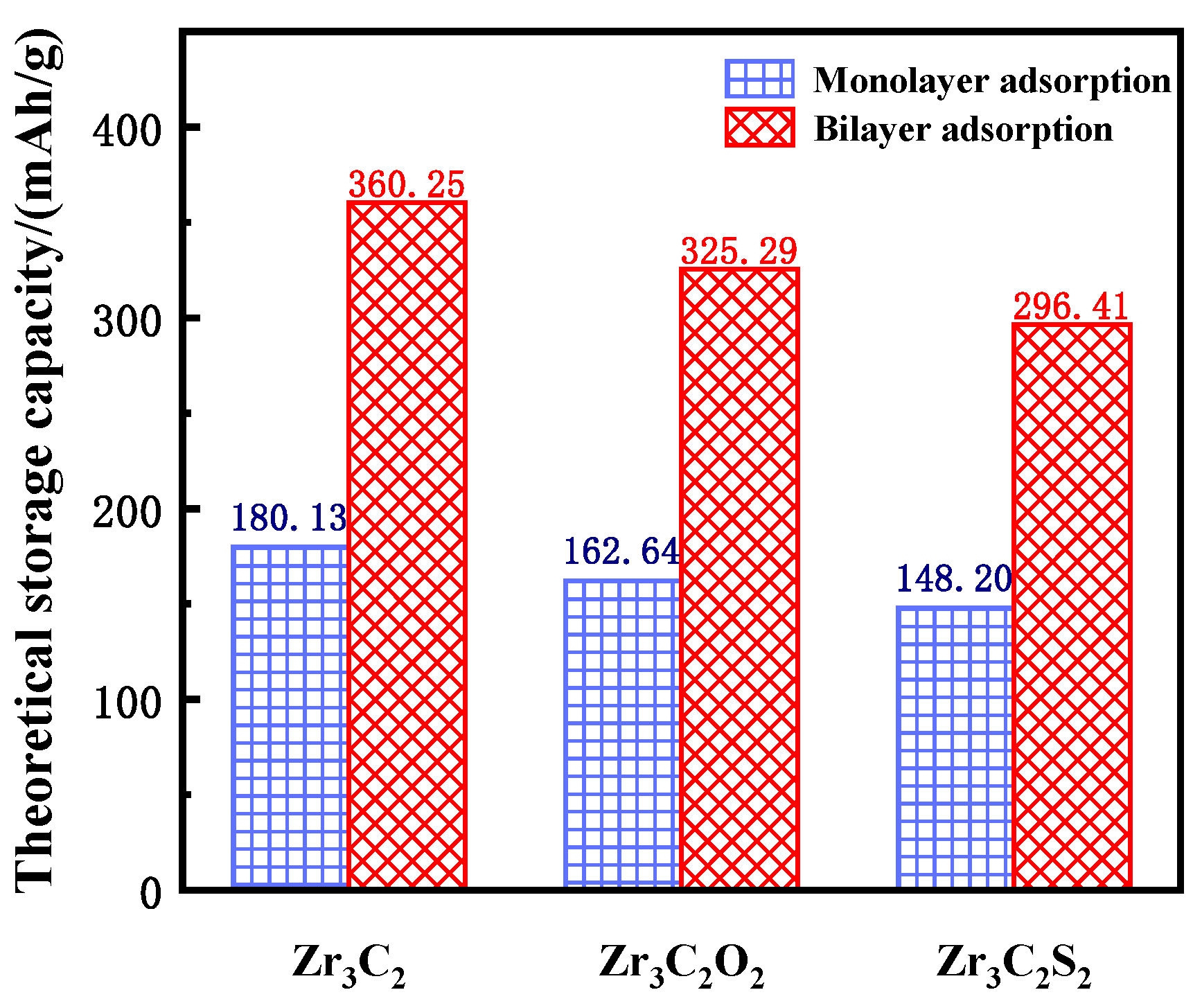Role of Oxygen and Halogen Functionalization in Tuning the Surface Properties of Zr3C2T2 MXene for Lithium Storage: A Density Functional Theory Study
Abstract
1. Introduction
2. Computing Method
3. Results and Discussion
3.1. Structural Properties
3.2. Electronic Properties
3.3. Lithium Storage Performance
4. Conclusions
Author Contributions
Funding
Institutional Review Board Statement
Informed Consent Statement
Data Availability Statement
Acknowledgments
Conflicts of Interest
References
- Zhao, W.; Zhao, C.; Wu, H.; Li, L.; Zhang, C. Progress, challenge and perspective of graphite-based anode materials for lithium batteries: A review. J. Energy Storage 2024, 81, 110409. [Google Scholar] [CrossRef]
- Lin, X.-W.; Li, Y.-B.; Wu, W.-T.; Zhou, Z.-F.; Chen, B. Advances on two-phase heat transfer for lithium-ion battery thermal management. Renew. Sustain. Energy Rev. 2024, 189, 114052. [Google Scholar] [CrossRef]
- Zhang, J.; Xia, L.; Yang, L.; Li, J.; Liu, Y.; Lan, D.; Zhang, S.; Wang, F.; Xu, J.; Liu, D. Ti3C2Tx MXene nanobelts with alkali ion intercalation: Dual-purpose for enhanced lithium-ion batteries and microwave absorption. Carbon 2025, 237, 120148. [Google Scholar] [CrossRef]
- Chen, K.; Yang, H.; Liang, F.; Xue, D. Microwave-irradiation-assisted combustion toward modified graphite as lithium ion battery anode. ACS Appl. Mater. Interfaces 2018, 10, 909–914. [Google Scholar] [CrossRef] [PubMed]
- Cheng, Y.; Huang, J.; Yu, F.; Zhou, Y.; Li, G.; Cheng, W.; Duan, P.; Qi, H.; Xie, H. Chemically bonded MXene/SnSe2 composite with special structural transformation as a high-performance anode for lithium and potassium ions battery. Chem. Eng. J. 2024, 481, 148737. [Google Scholar] [CrossRef]
- Zhu, M.; Han, D.; Cai, C.; Zhong, J.; Weng, J.; Tang, C.; Gao, F.; Zhang, J. Two-dimensional MXene/MOFs heterojunction nanosheets as confinement hosts for dendrite-free lithium metal anodes. Carbon 2024, 227, 119248. [Google Scholar] [CrossRef]
- Toyoura, K.; Koyama, Y.; Kuwabara, A.; Tanaka, I. Effects of off-stoichiometry of LiC6 on the lithium diffusion mechanism and diffusivity by first principles calculations. J. Phys. Chem. C 2010, 114, 2375–2379. [Google Scholar] [CrossRef]
- Zhou, L.-J.; Hou, Z.; Wu, L.-M.; Zhang, Y.-F. First-principles studies of lithium adsorption and diffusion on graphene with grain boundaries. J. Phys. Chem. C 2014, 118, 28055–28062. [Google Scholar] [CrossRef]
- Kong, C.-P.; Hu, Y.-Y.; Bai, F.-Q.; Zhang, H.-X.; Jia, R. F-GDY and F-GDY/Graphene as anodes in lithium-ion batteries: A first-principle investigation. Appl. Surf. Sci. 2022, 595, 153543. [Google Scholar] [CrossRef]
- Thomas, S.; Nam, E.B.; Lee, S.U. Atomistic dynamics investigation of the thermomechanical properties and Li diffusion kinetics in ψ-graphene for LIB anode material. ACS Appl. Mater. Interfaces 2018, 10, 36240–36248. [Google Scholar] [CrossRef]
- Li, L.; Li, Z.; Yoshimura, A.; Sun, C.; Wang, T.; Chen, Y.; Chen, Z.; Littlejohn, A.; Xiang, Y.; Hundekar, P. Vanadium disulfide flakes with nanolayered titanium disulfide coating as cathode materials in lithium-ion batteries. Nat. Commun. 2019, 10, 1764. [Google Scholar] [CrossRef]
- Seh, Z.W.; Yu, J.H.; Li, W.; Hsu, P.-C.; Wang, H.; Sun, Y.; Yao, H.; Zhang, Q.; Cui, Y. Two-dimensional layered transition metal disulphides for effective encapsulation of high-capacity lithium sulphide cathodes. Nat. Commun. 2014, 5, 5017. [Google Scholar] [CrossRef] [PubMed]
- Choi, D.S.; Yeom, M.S.; Kim, Y.-T.; Kim, H.; Jung, Y. Polyselenide anchoring using transition-metal disulfides for enhanced lithium–selenium batteries. Inorg. Chem. 2018, 57, 2149–2156. [Google Scholar] [CrossRef]
- Li, W.; Yang, Y.; Zhang, G.; Zhang, Y.-W. Ultrafast and directional diffusion of lithium in phosphorene for high-performance lithium-ion battery. Nano Lett. 2015, 15, 1691–1697. [Google Scholar] [CrossRef] [PubMed]
- Zhang, C.; Yu, M.; Anderson, G.; Dharmasena, R.R.; Sumanasekera, G. The prospects of phosphorene as an anode material for high-performance lithium-ion batteries: A fundamental study. Nanotechnology 2017, 28, 075401. [Google Scholar] [CrossRef]
- Yang, Z.; Li, W.; Zhang, J. First-principles study of borophene/phosphorene heterojunction as anode material for lithium-ion batteries. Nanotechnology 2021, 33, 075403. [Google Scholar] [CrossRef]
- Hu, R.; Xu, G.; Yang, Y.; Zhang, J.-M.; Zhong, K.; Huang, Z. Effect of stacking structure on lithium adsorption and diffusion in bilayer black phosphorene. Phys. Rev. B 2019, 100, 085422. [Google Scholar] [CrossRef]
- Tang, Q.; Zhou, Z.; Shen, P. Are MXenes promising anode materials for Li ion batteries? Computational studies on electronic properties and Li storage capability of Ti3C2 and Ti3C2x2 (X = F, OH) monolayer. J. Am. Chem. Soc. 2012, 134, 16909–16916. [Google Scholar] [CrossRef]
- Naguib, M.; Come, J.; Dyatkin, B.; Presser, V.; Taberna, P.-L.; Simon, P.; Barsoum, M.W.; Gogotsi, Y. MXene: A promising transition metal carbide anode for lithium-ion batteries. Electrochem. Commun. 2012, 16, 61–64. [Google Scholar] [CrossRef]
- Nan, J.; Guo, X.; Xiao, J.; Li, X.; Chen, W.; Wu, W.; Liu, H.; Wang, Y.; Wu, M.; Wang, G. Nanoengineering of 2D MXene-based materials for energy storage applications. Small 2021, 17, 1902085. [Google Scholar] [CrossRef]
- Xiong, D.; Li, X.; Bai, Z.; Lu, S. Recent advances in layered Ti3C2Tx MXene for electrochemical energy storage. Small 2018, 14, 1703419. [Google Scholar] [CrossRef]
- Xie, Y.; Naguib, M.; Mochalin, V.N.; Barsoum, M.W.; Gogotsi, Y.; Yu, X.; Nam, K.-W.; Yang, X.-Q.; Kolesnikov, A.I.; Kent, P.R. Role of surface structure on Li-ion energy storage capacity of two-dimensional transition-metal carbides. J. Am. Chem. Soc. 2014, 136, 6385–6394. [Google Scholar] [CrossRef]
- Luo, J.; Tao, X.; Zhang, J.; Xia, Y.; Huang, H.; Zhang, L.; Gan, Y.; Liang, C.; Zhang, W. Sn4+ ion decorated highly conductive Ti3C2 MXene: Promising lithium-ion anodes with enhanced volumetric capacity and cyclic performance. ACS Nano 2016, 10, 2491–2499. [Google Scholar] [CrossRef] [PubMed]
- Zhou, J.; Lin, S.; Huang, Y.; Tong, P.; Zhao, B.; Zhu, X.; Sun, Y. Synthesis and lithium ion storage performance of two-dimensional V4C3 MXene. Chem. Eng. J. 2019, 373, 203–212. [Google Scholar] [CrossRef]
- Wang, D.; Zhang, K.; Zhu, Y.; Lan, Y.; Hu, L.; Lin, N.; Zhou, J.; Qian, Y. A novel strategy to prepare graphene oxide-wrapped nanocrystals composite for high-performance lithium storage. Mater. Lett. 2016, 175, 32–35. [Google Scholar] [CrossRef]
- Jing, Y.; Zhou, Z.; Cabrera, C.R.; Chen, Z. Graphene, inorganic graphene analogs and their composites for lithium ion batteries. J. Mater. Chem. A 2014, 2, 12104–12122. [Google Scholar] [CrossRef]
- Hao, J.; Zheng, J.; Ling, F.; Chen, Y.; Jing, H.; Zhou, T.; Fang, L.; Zhou, M. Strain-engineered two-dimensional MoS2 as anode material for performance enhancement of Li/Na-ion batteries. Sci. Rep. 2018, 8, 2079. [Google Scholar] [CrossRef]
- Naguib, M.; Kurtoglu, M.; Presser, V.; Lu, J.; Niu, J.; Heon, M.; Hultman, L.; Gogotsi, Y.; Barsoum, M.W. Two-dimensional nanocrystals produced by exfoliation of Ti3AlC2. In MXenes; Jenny Stanford Publishing: Singapore, 2011; pp. 15–29. [Google Scholar]
- Folorunso, O.; Kumar, N.; Hamam, Y.; Sadiku, R.; Ray, S.S. Recent progress on 2D metal carbide/nitride (MXene) nanocomposites for lithium-based batteries. FlatChem 2021, 29, 100281. [Google Scholar] [CrossRef]
- Dong, Y.; Shi, H.; Wu, Z.S. Recent advances and promise of MXene-based nanostructures for high-performance metal ion batteries. Adv. Funct. Mater. 2020, 30, 2000706. [Google Scholar] [CrossRef]
- Shein, I.; Ivanovskii, A. Graphene-like titanium carbides and nitrides Tin+1Cn, Tin+1Nn (n = 1, 2, and 3) from de-intercalated MAX phases: First-principles probing of their structural, electronic properties and relative stability. Comput. Mater. Sci. 2012, 65, 104–114. [Google Scholar] [CrossRef]
- Enyashin, A.N.; Ivanovskii, A.L. Structural and electronic properties and stability of MXenes Ti2C and Ti3C2 functionalized by methoxy groups. J. Phys. Chem. C 2013, 117, 13637–13643. [Google Scholar] [CrossRef]
- Shahpouri, E.; Hassani, S.; Yousefi-Mashhour, H.; Kalantarian, M.M.; Ebadzadeh, T.; Mobasherpour, I. Evaluation of Ti3C2 as electrode material for Li, Na, Mg, Al, K, Ca, and Zn-ion intercalation batteries: A DFT study. Results Chem. 2024, 7, 101385. [Google Scholar] [CrossRef]
- Zhou, H.-Y.; Lin, L.-W.; Sui, Z.-Y.; Wang, H.-Y.; Han, B.-H. Holey Ti3C2 MXene-derived anode enables boosted kinetics in lithium-ion capacitors. ACS Appl. Mater. Interfaces 2023, 15, 12161–12170. [Google Scholar] [CrossRef]
- Chen, Z.-F.; Chen, X.; Chen, C.; Lai, X.; Qin, J.; Chen, C.; Sun, D. A thin, intrinsically stretchable MXene-MWCNTs/polymer current collector for deformable aqueous Li-ion batteries. J. Mater. Chem. A 2024, 12, 2444–2455. [Google Scholar] [CrossRef]
- Bayhan, Z.; El-Demellawi, J.K.; Yin, J.; Khan, Y.; Lei, Y.; Alhajji, E.; Wang, Q.; Hedhili, M.N.; Alshareef, H.N. A laser-induced Mo2CTx MXene hybrid anode for high-performance Li-ion batteries. Small 2023, 19, 2208253. [Google Scholar] [CrossRef]
- Guo, Y.; Liu, D.; Huang, B.; Wang, L.; Xia, Q.; Zhou, A. Effects of surface compositions and interlayer distance on electrochemical performance of Mo2CTx MXene as anode of Li-ion batteries. J. Phys. Chem. Solids 2023, 176, 111238. [Google Scholar] [CrossRef]
- Mashtalir, O.; Lukatskaya, M.R.; Zhao, M.-Q.; Barsoum, M.W.; Gogotsi, Y. Amine-assisted delamination of Nb2C MXene for Li-ion energy storage devices. In MXenes; Jenny Stanford Publishing: Singapore, 2023; pp. 401–414. [Google Scholar]
- Jiang, Y.; Tian, M.; Wang, H.; Wei, C.; Sun, Z.; Rummeli, M.H.; Strasser, P.; Sun, J.; Yang, R. Mildly oxidized MXene (Ti3C2, Nb2C, and V2C) electrocatalyst via a generic strategy enables longevous Li–O2 battery under a high rate. ACS Nano 2021, 15, 19640–19650. [Google Scholar] [CrossRef]
- Chen, Z.; Liu, Z.; Yuan, X.; Zhou, N. O-and S-terminated M2C MXenes as anode materials for Na/K-ion batteries. J. Phys. Chem. C 2022, 126, 4267–4275. [Google Scholar] [CrossRef]
- Liu, J.; Zhang, M.; Zhang, D.; Liu, X. V2CTx MXene-Encapsulated Liquid Metal Composite as an Anode for Wide-Temperature Li-Ion Batteries. Energy Fuels 2024, 38, 11284–11291. [Google Scholar] [CrossRef]
- Luo, H.; Long, P.; Xiao, J.; Dai, X.; Wang, Z. Mo2CS2 MXene as a promising anode material for metal ion batteries: A first-principles study. Mater. Today Commun. 2024, 38, 108285. [Google Scholar] [CrossRef]
- Liu, J.; Xu, X.; Wang, H.; Wang, P.-F.; Wu, K.; Cheng, Y.; Xiao, B. Achieving high electrical conductivity, energy storage capacity and cycling stability in ammoniated Mo 2 TiC2Tx MXenes as an anode for lithium-ion batteries. J. Mater. Chem. A 2024, 12, 26962–26979. [Google Scholar] [CrossRef]
- Zhou, M.; Shen, Y.; Lv, L.; Zhang, Y.; Meng, X.; Yang, X.; He, Q.; Zhang, B.; Zhou, Z. Bare W-based MXenes (WCrC and MoWC) anode with high specific capacity for Li and Mg-ion batteries. J. Phys. D Appl. Phys. 2023, 57, 015502. [Google Scholar] [CrossRef]
- Wang, D.; Li, F.; Lian, R.; Xu, J.; Kan, D.; Liu, Y.; Chen, G.; Gogotsi, Y.; Wei, Y. A general atomic surface modification strategy for improving anchoring and electrocatalysis behavior of Ti3C2T2 MXene in lithium–sulfur batteries. ACS Nano 2019, 13, 11078–11086. [Google Scholar] [CrossRef] [PubMed]
- Wang, L.; Wang, J.; Zhang, Z.; Wang, L.; Wang, W.; Liu, J.; Hong, Z.; Cho, K.; Wang, W. Origin of theoretical pseudocapacitance of two-dimensional supercapacitor electrodes Ti3C2T2 (T = bare, O, S). J. Mater. Chem. A 2019, 7, 16231–16238. [Google Scholar] [CrossRef]
- Li, H.; Li, A.; Zhang, D.; Wu, Q.; Mao, P.; Qiu, Y.; Zhao, Z.; Yu, P.; Su, X.; Bai, M. First-principles study on the structural, electronic, and lithium storage properties of Ti3C2T2 (T = O, F, H, OH) MXene. ACS Omega 2022, 7, 40578–40585. [Google Scholar] [CrossRef]
- Li, K.; Zeng, J.; Wang, Y.; Zhang, J.; Zhou, Y. A first-principles study of the lithium storage properties of transition metal doped TM-Ti2CO2 (TM = Sc, V, Cr, Mn, Fe, Co, Ni and Cu). Mater. Today Commun. 2024, 40, 109718. [Google Scholar] [CrossRef]
- Abdelsalam, H.; Sakr, M.A.; Teleb, N.H.; Abdelrazek, G.M.; Abd-Elkader, O.H.; Zhang, Q. Unveiling lithium storage potential in Zr2C and Zr2CO2 MXenes: A study of structural stability, electronic properties, and adsorption behavior. Mater. Sci. Eng. B 2025, 314, 118017. [Google Scholar] [CrossRef]
- Zhou, J.; Zha, X.; Chen, F.Y.; Ye, Q.; Eklund, P.; Du, S.; Huang, Q. A two-dimensional zirconium carbide by selective etching of Al3C3 from nanolaminated Zr3Al3C5. Angew. Chem. Int. Ed. 2016, 55, 5008–5013. [Google Scholar] [CrossRef]
- Meng, Q.; Ma, J.; Zhang, Y.; Li, Z.; Hu, A.; Kai, J.-J.; Fan, J. Theoretical investigation of zirconium carbide MXenes as prospective high capacity anode materials for Na-ion batteries. J. Mater. Chem. A 2018, 6, 13652–13660. [Google Scholar] [CrossRef]
- Khan, S.; Kumar, N.; Hussain, T.; Tit, N. Functionalized Hf3C2 and Zr3C2 MXenes for suppression of shuttle effect to enhance the performance of sodium–sulfur batteries. J. Power Sources 2023, 580, 233298. [Google Scholar] [CrossRef]
- Kadangodan Putiyaveettil, A.; Natesan, B. Computational Insights into the Influence of Surface Functionalization Groups on Zirconium Carbide MXenes as Anode Materials for Lithium-Ion Batteries. J. Phys. Chem. C 2024, 128, 12777–12791. [Google Scholar] [CrossRef]
- Khan, K.; Tareen, A.K.; Ahmad, W.; Hussain, I.; Chaudhry, M.U.; Mahmood, A.; Khan, M.F.; Zhang, H.; Xie, Z. Recent Advances in Non-Ti MXenes: Synthesis, Properties, and Novel Applications. Adv. Sci. 2024, 11, 2303998. [Google Scholar] [CrossRef] [PubMed]
- Clark, S.J.; Segall, M.D.; Pickard, C.J.; Hasnip, P.J.; Probert, M.I.; Refson, K.; Payne, M.C. First principles methods using CASTEP. Z. Krist.-Cryst. Mater. 2005, 220, 567–570. [Google Scholar] [CrossRef]
- Vanderbilt, D. Soft self-consistent pseudopotentials in a generalized eigenvalue formalism. Phys. Rev. B 1990, 41, 7892. [Google Scholar] [CrossRef]
- Perdew, J.P.; Burke, K.; Ernzerhof, M. Generalized gradient approximation made simple. Phys. Rev. Lett. 1996, 77, 3865. [Google Scholar] [CrossRef]
- Monkhorst, H.J.; Pack, J.D. Special points for Brillouin-zone integrations. Phys. Rev. B 1976, 13, 5188. [Google Scholar] [CrossRef]
- Fischer, T.H.; Almlof, J. General methods for geometry and wave function optimization. J. Phys. Chem. 1992, 96, 9768–9774. [Google Scholar] [CrossRef]
- Jain, A.; Ong, S.P.; Hautier, G.; Chen, W.; Richards, W.D.; Dacek, S.; Cholia, S.; Gunter, D.; Skinner, D.; Ceder, G. Commentary: The Materials Project: A materials genome approach to accelerating materials innovation. APL Mater. 2013, 1, 011002. [Google Scholar] [CrossRef]
- Wang, C.-Y.; Guo, Y.-L.; Zhao, Y.-Y.; Zeng, G.-L.; Zhang, W.; Ren, C.-L.; Han, H.; Huai, P. A first-principles study on the vibrational and electronic properties of Zr-C MXenes. Commun. Theor. Phys. 2018, 69, 336. [Google Scholar] [CrossRef]
- Li, H.; Qiu, Y.; Gao, D.; Wang, Y.; Zhou, T.; Gao, T.; Xie, Z.; Xu, K.; Yu, P. First-principles study on the adsorption and lithium storage capacities of Hf3C2 and Hf3C2T2 (T = O, F, S) MXenes. FlatChem 2023, 41, 100539. [Google Scholar] [CrossRef]
- Ma, S.; Fan, X.; An, Y.; Yang, D.; Luo, Z.; Hu, Y.; Guo, N. Exploring the catalytic activity of MXenes Mn+1CnO2 for hydrogen evolution. J. Mater. Sci. 2019, 54, 11378–11389. [Google Scholar] [CrossRef]
- Er, D.; Li, J.; Naguib, M.; Gogotsi, Y.; Shenoy, V.B. Ti3C2 MXene as a high capacity electrode material for metal (Li, Na, K, Ca) ion batteries. ACS Appl. Mater. Interfaces 2014, 6, 11173–11179. [Google Scholar] [CrossRef] [PubMed]







| Zr3C2T2 | a (Å) | h (Å) | Formation Energy (eV) | Work Function (eV) |
|---|---|---|---|---|
| Zr3C2 | 3.330 | 5.100 | / | 3.83 |
| Zr3C2O2 | 3.322 | 7.333 | −6.173 | 8.16 |
| Zr3C2S2 | 3.320 | 8.774 | −4.169 | 6.61 |
| Zr3C2F2 | 3.328 | 8.394 | −5.605 | 5.44 |
| Zr3C2Cl2 | 3.325 | 8.845 | −4.010 | 4.65 |
| Zr3C2T2 | Species | s | p | d | Total | Charge (e) |
|---|---|---|---|---|---|---|
| Zr3C2 | C | 1.49 | 3.29 | 0 | 4.78 | −0.78 |
| C | 1.49 | 3.29 | 0 | 4.78 | −0.78 | |
| Zr | 2.51 | 6.49 | 2.67 | 11.67 | 0.33 | |
| Zr | 2.51 | 6.49 | 2.67 | 11.67 | 0.33 | |
| Zr | 2.14 | 6.31 | 2.64 | 11.1 | 0.9 | |
| Zr3C2O2 | C | 1.49 | 3.31 | 0 | 4.8 | −0.8 |
| C | 1.49 | 3.31 | 0 | 4.8 | −0.8 | |
| Zr | 2.18 | 6.32 | 2.41 | 10.91 | 1.09 | |
| Zr | 2.18 | 6.32 | 2.41 | 10.91 | 1.09 | |
| Zr | 2.1 | 6.4 | 2.7 | 11.2 | 0.8 | |
| O | 1.87 | 4.81 | 0 | 6.69 | −0.69 | |
| O | 1.87 | 4.81 | 0 | 6.69 | −0.69 | |
| Zr3C2S2 | C | 1.52 | 3.28 | 0 | 4.8 | −0.8 |
| C | 1.52 | 3.28 | 0 | 4.8 | −0.8 | |
| Zr | 2.33 | 6.45 | 2.61 | 11.38 | 0.62 | |
| Zr | 2.33 | 6.45 | 2.61 | 11.38 | 0.62 | |
| Zr | 2.19 | 6.46 | 2.57 | 11.22 | 0.78 | |
| S | 1.87 | 4.35 | 0 | 6.21 | −0.21 | |
| S | 1.87 | 4.35 | 0 | 6.21 | −0.21 | |
| Zr3C2F2 | C | 1.48 | 3.35 | 0 | 4.83 | −0.83 |
| C | 1.48 | 3.35 | 0 | 4.83 | −0.83 | |
| Zr | 2.23 | 6.31 | 2.5 | 11.03 | 0.97 | |
| Zr | 2.23 | 6.31 | 2.5 | 11.03 | 0.97 | |
| Zr | 2.14 | 6.42 | 2.66 | 11.23 | 0.77 | |
| F | 1.95 | 5.57 | 0 | 7.52 | −0.52 | |
| F | 1.95 | 5.57 | 0 | 7.52 | −0.52 | |
| Zr3C2Cl2 | C | 1.49 | 3.32 | 0 | 4.81 | −0.81 |
| C | 1.49 | 3.32 | 0 | 4.81 | −0.81 | |
| Zr | 2.31 | 6.39 | 2.62 | 11.32 | 0.68 | |
| Zr | 2.31 | 6.39 | 2.62 | 11.32 | 0.68 | |
| Zr | 2.17 | 6.42 | 2.64 | 11.23 | 0.77 | |
| Cl | 1.94 | 5.31 | 0 | 7.25 | −0.25 | |
| Cl | 1.94 | 5.31 | 0 | 7.25 | −0.25 |
Disclaimer/Publisher’s Note: The statements, opinions and data contained in all publications are solely those of the individual author(s) and contributor(s) and not of MDPI and/or the editor(s). MDPI and/or the editor(s) disclaim responsibility for any injury to people or property resulting from any ideas, methods, instructions or products referred to in the content. |
© 2025 by the authors. Licensee MDPI, Basel, Switzerland. This article is an open access article distributed under the terms and conditions of the Creative Commons Attribution (CC BY) license (https://creativecommons.org/licenses/by/4.0/).
Share and Cite
Li, H.; Xie, Z.; Gao, T.; Liu, J.; Lu, W.; Liu, Y.; Wang, S. Role of Oxygen and Halogen Functionalization in Tuning the Surface Properties of Zr3C2T2 MXene for Lithium Storage: A Density Functional Theory Study. Materials 2025, 18, 1237. https://doi.org/10.3390/ma18061237
Li H, Xie Z, Gao T, Liu J, Lu W, Liu Y, Wang S. Role of Oxygen and Halogen Functionalization in Tuning the Surface Properties of Zr3C2T2 MXene for Lithium Storage: A Density Functional Theory Study. Materials. 2025; 18(6):1237. https://doi.org/10.3390/ma18061237
Chicago/Turabian StyleLi, Hui, Zhengyang Xie, Tianwei Gao, Jinyi Liu, Wenke Lu, Yue Liu, and Shouwei Wang. 2025. "Role of Oxygen and Halogen Functionalization in Tuning the Surface Properties of Zr3C2T2 MXene for Lithium Storage: A Density Functional Theory Study" Materials 18, no. 6: 1237. https://doi.org/10.3390/ma18061237
APA StyleLi, H., Xie, Z., Gao, T., Liu, J., Lu, W., Liu, Y., & Wang, S. (2025). Role of Oxygen and Halogen Functionalization in Tuning the Surface Properties of Zr3C2T2 MXene for Lithium Storage: A Density Functional Theory Study. Materials, 18(6), 1237. https://doi.org/10.3390/ma18061237






